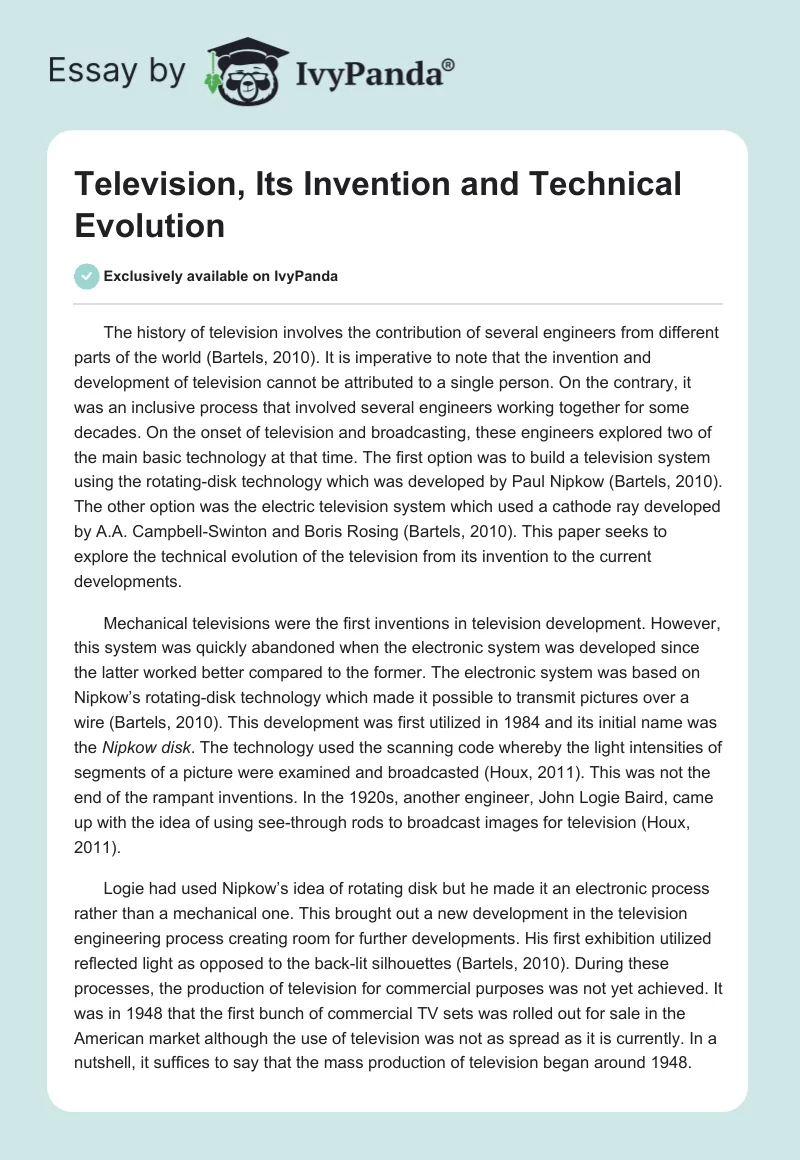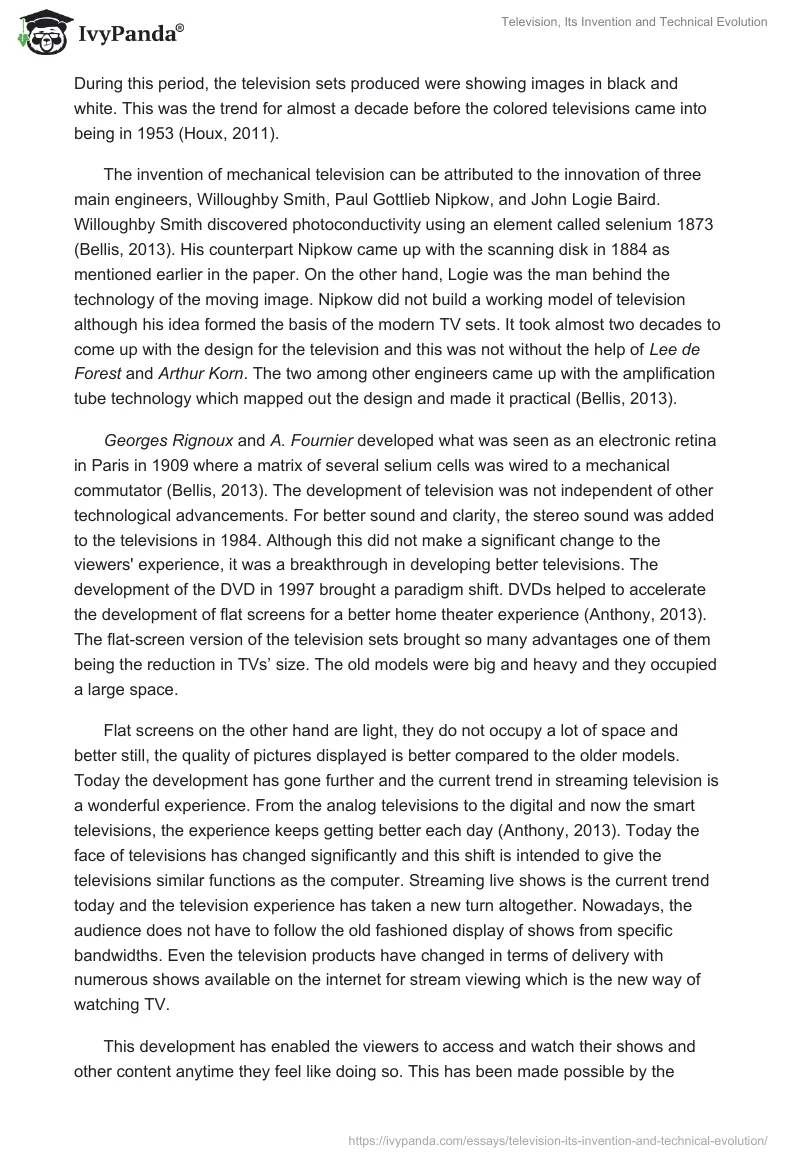The history of television involves the contribution of several engineers from different parts of the world (Bartels, 2010). It is imperative to note that the invention and development of television cannot be attributed to a single person. On the contrary, it was an inclusive process that involved several engineers working together for some decades. On the onset of television and broadcasting, these engineers explored two of the main basic technology at that time. The first option was to build a television system using the rotating-disk technology which was developed by Paul Nipkow (Bartels, 2010). The other option was the electric television system which used a cathode ray developed by A.A. Campbell-Swinton and Boris Rosing (Bartels, 2010). This paper seeks to explore the technical evolution of the television from its invention to the current developments.
Mechanical televisions were the first inventions in television development. However, this system was quickly abandoned when the electronic system was developed since the latter worked better compared to the former. The electronic system was based on Nipkow’s rotating-disk technology which made it possible to transmit pictures over a wire (Bartels, 2010). This development was first utilized in 1984 and its initial name was the Nipkow disk. The technology used the scanning code whereby the light intensities of segments of a picture were examined and broadcasted (Houx, 2011). This was not the end of the rampant inventions. In the 1920s, another engineer, John Logie Baird, came up with the idea of using see-through rods to broadcast images for television (Houx, 2011).
Logie had used Nipkow’s idea of rotating disk but he made it an electronic process rather than a mechanical one. This brought out a new development in the television engineering process creating room for further developments. His first exhibition utilized reflected light as opposed to the back-lit silhouettes (Bartels, 2010). During these processes, the production of television for commercial purposes was not yet achieved. It was in 1948 that the first bunch of commercial TV sets was rolled out for sale in the American market although the use of television was not as spread as it is currently. In a nutshell, it suffices to say that the mass production of television began around 1948. During this period, the television sets produced were showing images in black and white. This was the trend for almost a decade before the colored televisions came into being in 1953 (Houx, 2011).
The invention of mechanical television can be attributed to the innovation of three main engineers, Willoughby Smith, Paul Gottlieb Nipkow, and John Logie Baird. Willoughby Smith discovered photoconductivity using an element called selenium 1873 (Bellis, 2013). His counterpart Nipkow came up with the scanning disk in 1884 as mentioned earlier in the paper. On the other hand, Logie was the man behind the technology of the moving image. Nipkow did not build a working model of television although his idea formed the basis of the modern TV sets. It took almost two decades to come up with the design for the television and this was not without the help of Lee de Forest and Arthur Korn. The two among other engineers came up with the amplification tube technology which mapped out the design and made it practical (Bellis, 2013).
Georges Rignoux and A. Fournier developed what was seen as an electronic retina in Paris in 1909 where a matrix of several selium cells was wired to a mechanical commutator (Bellis, 2013). The development of television was not independent of other technological advancements. For better sound and clarity, the stereo sound was added to the televisions in 1984. Although this did not make a significant change to the viewers’ experience, it was a breakthrough in developing better televisions. The development of the DVD in 1997 brought a paradigm shift. DVDs helped to accelerate the development of flat screens for a better home theater experience (Anthony, 2013). The flat-screen version of the television sets brought so many advantages one of them being the reduction in TVs’ size. The old models were big and heavy and they occupied a large space.
Flat screens on the other hand are light, they do not occupy a lot of space and better still, the quality of pictures displayed is better compared to the older models. Today the development has gone further and the current trend in streaming television is a wonderful experience. From the analog televisions to the digital and now the smart televisions, the experience keeps getting better each day (Anthony, 2013). Today the face of televisions has changed significantly and this shift is intended to give the televisions similar functions as the computer. Streaming live shows is the current trend today and the television experience has taken a new turn altogether. Nowadays, the audience does not have to follow the old fashioned display of shows from specific bandwidths. Even the television products have changed in terms of delivery with numerous shows available on the internet for stream viewing which is the new way of watching TV.
This development has enabled the viewers to access and watch their shows and other content anytime they feel like doing so. This has been made possible by the current trend where technology has made it possible for people to access the internet through their television sets. This has broadened the viewers’ options since many shows are accessible through the internet. Viewers have the option to stream live from their television sets for shows and programs offered on rent or for free on the internet. To be precise, the internet has taken over and changed the way people consume the products offered for television viewing. The old viewing where limited choices were present for the audience to choose from is gradually facing out giving way for the new smart viewing.
This paper has discussed the technical evolution of television, exploring its development from the first invention to date. Some engineers who are believed to have had the greatest role in the evolution process have also been mentioned in this paper as well as the period of invention. The paper has not only discussed the evolution trends in the past and old models but also in the current technological development of televisions citing how the inception of smart TVs has changed viewing. It concludes with an insight on how the internet has been crucial in the current development changing the consumption of television products in a very significant way. This paper has presented a concise chronological account of the evolution of television with rich content on the technical as well as technological development.
References
Anthony, A. (2013). A history of television, the technology that seduced the world – and me. Web.
Bartels, E. (2010). The Evolution of Television. Web.
Bellis, M. (2013).Television History. Web.
Houx, D. (2011). Evolution of TV: 8 Ways Television Has Changed From the 30’s to Today. Web.


